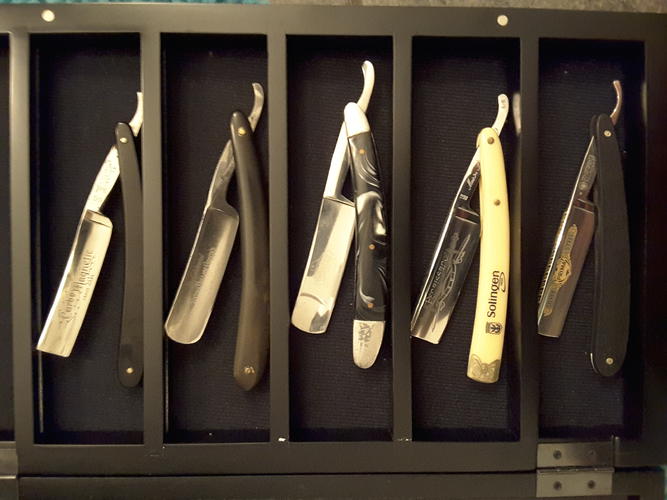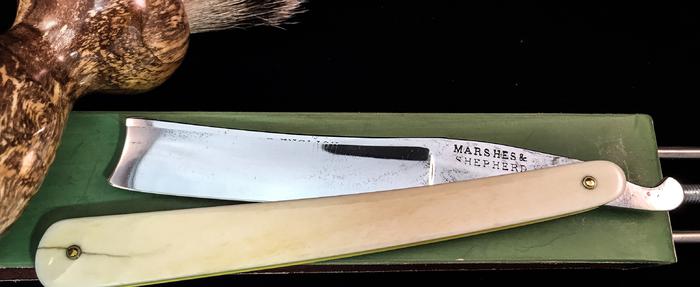Results 11 to 20 of 21
Thread: Please help, looking for info
-
10-09-2016, 09:16 PM #11

Looks like it may be the "Chinese" on Sheffield razors that isn't actually Chinese.
I'd also guess the blade was reground, and I wonder if the thumb notch is original.
-
The Following User Says Thank You to holli4pirating For This Useful Post:
adamtracy3 (10-10-2016)
-
10-09-2016, 11:38 PM #12

Yeah, I am with Holli on it. Looks like the remnants of the fake Chinese in the tang.
I do think the curved part of the thumb notch is original to the razor due to the jimps along it.
Seems Jos Elliott did that with 'Elliotts Chinese razor' on the front blade face.
Others likely did as well. Most everyone did a 'Chinese' razor in that period.
Anyhoo, a total custom regrind, likely done long, long ago.
Clean it a bit, hone it up! Might be the best razor ever! I love the old regrinds, myself!
If my (speculative) speculation is accurate, a Sheffield razor from mid-1800's and modded at turn of century. Still around!
Last edited by sharptonn; 10-10-2016 at 12:27 AM.
-
The Following User Says Thank You to sharptonn For This Useful Post:
adamtracy3 (10-10-2016)
-
10-10-2016, 12:58 AM #13Junior Member

- Join Date
- Jan 2016
- Location
- Genoa, Illinois
- Posts
- 9
Thanked: 2
The only reason I think it's hand hammered is because it has these lines in it across the length of the blade that are fairly consistent, and there's no removing them. They won't go away, but it's not pitting either, it's really strange to me. If you look at the third picture down, you can kind of see those black lines. That's the best I could clean it up as well, it won't get any brighter, and it doesn't rusty, tarnish, or stain, so it's not a typical metal, but it's also not stay brite coated.
-
10-10-2016, 01:07 AM #14Junior Member

- Join Date
- Jan 2016
- Location
- Genoa, Illinois
- Posts
- 9
Thanked: 2
As far as cleaned up, that's as clean as I can get it without grinding. The reason I ask is because it is by far my best razor, and I've got some pretty nice ones. It gets the sharpest of anything I currently have, and it maintains an edge longer than any of my other razors. This is a small collection of some of my better razors, and it's better than any of them.

-
10-10-2016, 01:10 AM #15Junior Member

- Join Date
- Jan 2016
- Location
- Genoa, Illinois
- Posts
- 9
Thanked: 2
-
10-10-2016, 01:24 AM #16Member

- Join Date
- Nov 2015
- Location
- Dallas, TX
- Posts
- 88
Thanked: 24
Supposedly during one or the other Opium Wars, English makers used made up Chinese characters as a marketing tool on their razors to capture the imagination of the English public. The scales look to be ebonite, rub them with a finger to generate a bit of friction then smell them. Burning tire smell = ebonite, which would likely mean the scales are original and would fit the era.
As far as the blade being reground they are talking about it being a full hollow grind now and I believe that got perfected in the late 19th century. The tang or the shank of the blade indicates an earlier time period than say 1880 and the blade was most likely a 1/4-1/2 hollow or maybe a near wedge. Im no expert but thats my guess. Maybe someone else will have some better info for you. Cool razor tho, hone her up and enjoy.
Cheers,
Brian
-
The Following User Says Thank You to BadB For This Useful Post:
adamtracy3 (10-10-2016)
-
10-10-2016, 01:33 AM #17Junior Member

- Join Date
- Jan 2016
- Location
- Genoa, Illinois
- Posts
- 9
Thanked: 2
-
10-10-2016, 02:10 AM #18

Look at it and compare it to old Wedge-ground wedges from the mid-1800's.
Everything was there and can be seen to have been there. Yet lots has been ground away. As razors became thinner toward 1900, there were many with the skills and grinding apparatus to make a transition to a 'new' type razor. I am usually able to see it from across the road.
In this case, from a mile away.
Not always a bad thing!
-
The Following 2 Users Say Thank You to sharptonn For This Useful Post:
adamtracy3 (10-10-2016), Hirlau (10-10-2016)
-
10-10-2016, 02:54 AM #19Member

- Join Date
- Nov 2015
- Location
- Dallas, TX
- Posts
- 88
Thanked: 24
Heres my personal example of a regrind; a Marshes & Sheperd stub tail in a hollow grind. The clues come the tang, blade shoulder, stabilizer and the tail itself, but the biggest clue...the remains of the tops of the letters OLD ENGLISH on the blade face.
Like Sharptonn said characteristics of an older era exist on your razor, but there are modifications that don't appear until years later as well. Nothing but experience will enable you to tell the difference..unless you post on a friendly forum like this with helpful and knowledgeable members, lol.
I bought Straight Razor collecting by Robert Doyle (out of print) as a general baseline for collecting knowledge. The same information is available online, but not really in one concise format. The book is alright, the bulk of it deals with pricing from the 1990's and is no longer relevant, but it helps give you a timeline on terms of razor development, blade shapes, grinds, handle materials and styles etc.
-
The Following User Says Thank You to BadB For This Useful Post:
adamtracy3 (10-10-2016)
-
10-10-2016, 03:48 AM #20
-
The Following User Says Thank You to holli4pirating For This Useful Post:
adamtracy3 (10-10-2016)


 27Likes
27Likes LinkBack URL
LinkBack URL About LinkBacks
About LinkBacks







 Reply With Quote
Reply With Quote

